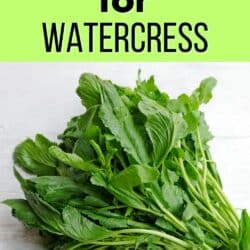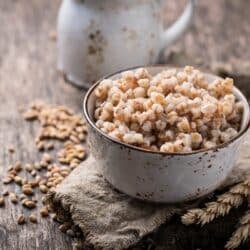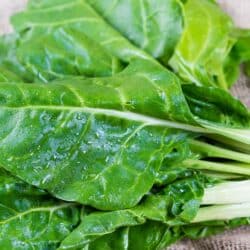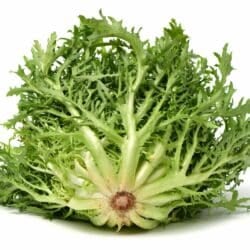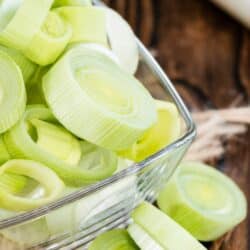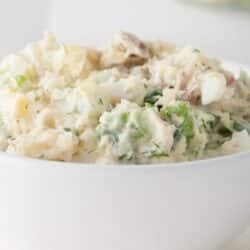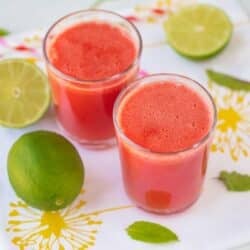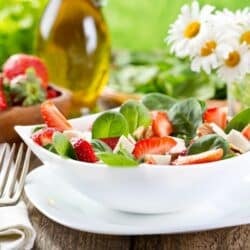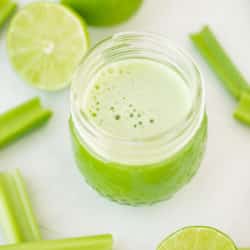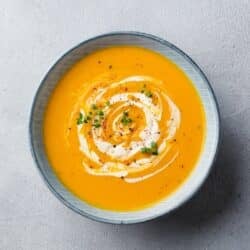7 Best Substitutes for Watercress (Soup or Salad)
If you need watercress in a recipe, but don’t have any on hand, you’re in luck! There are many great substitutes that can give your food that same delicious flavor, nutrition, and texture. Here are some of the best substitutes for watercress including arugula, baby spinach, endive, radish sprouts, dandelion greens, mustard greens, and kale.

Overview of Watercress
Green, leafy watercress is a highly nutritious leafy green vegetable related to broccoli and kale.
One of the oldest known leaf vegetables consumed by humans, it is a semi-aquatic plant (hence the name) and is often grown close to natural freshwater sources. It’s also known as upland cress.
Watercress has a distinctive peppery flavor and is a very versatile ingredient, used in a range of dishes all over the world. It has a crunch texture and peppery taste. It’s also a cruciferous vegetable part of the mustard family.
Culinary Uses
Watercress is delicious both cooked and raw – in fact, some people prefer to cook it as it mellows down its peppery flavor and makes for a more mild flavor.
It’s wonderful in salads, pairing perfectly with olive oil and lemon juice vinaigrette, and it makes a tasty and nutritious addition to sandwiches, wraps, and even burgers.
In the United States and across Europe it’s a popular smoothie ingredient (it does have a strong flavor, though, so watch out!), and it’s often used in stir-fries in Chinese cooking.
But watercress is probably best-loved for making soup! Watercress soup is a traditional dish in the UK, where it is often blended with a little cream to bring out its lovely, peppery flavor.
Watercress is also the star ingredient in Caldo Verde – a traditional Portuguese green soup – and the French “Soupe au Cresson.”
Why Watercress is Good for You
Low in calories, watercress is a nutritional powerhouse and one of the most beneficial veggies you can include in your diet! It’s on my list of the best green vegetables.
It’s an excellent source of vitamin K which is important for blood clotting and bone health, and is rich in vitamin C, a powerful antioxidant that helps support your immune system.
It contains beta-carotene, a pigment that your body converts to vitamin A. This is used to support the function of multiple organs and is essential for good vision.
It also contains calcium – vital for the health of your bones – and iron, which you need to make red blood cells and carry oxygen around the body. Indeed, watercress is a great source of iron if you’re following a vegan or vegetarian diet.
What’s more, studies have shown that watercress may have potent anti-cancer properties, especially when consumed raw. That’s because it is one of the best sources of phenethyl isothiocyanate (PEITC), a compound that can help prevent the growth of cancer cells.
Best Substitutes
Planning on preparing a dish that calls for watercress, only to find you have none available?
Here are the best alternatives to try and how they compare.
1. Arugula (Rocket)
Arugula is my number one choice as a great substitute for watercress because it shares its spicy, peppery flavor.
That said, arugula may be just a little more peppery than watercress – so if that’s what you’re trying to get away from, try a milder option (like spinach) instead.
Arugula leaves are less crispy than watercress, so though you can still use them raw in a salad, you may notice a difference in texture.
You can also use them in sandwiches or wraps, or wilt them slightly and add them to soups and other warm dishes.
The good news is that you won’t miss out on nutrition when replacing watercress with arugula. That’s because it is a good source of vitamins A, C, and K, calcium, and folate.
To substitute one cup of watercress, use one cup of arugula.
2. Baby Spinach
If you’re looking for a substitute for watercress because you find it too spicy, you’ll love the milder taste of spinach leaves instead. They also bring a sweetness to dishes that watercress lacks.
Spinach leaves are a leafy vegetable that is softer than watercress. They work well in salads but wilt easily, too, providing a softer consistency in cooked dishes. Spinach just doesn’t have the same crunchy texture that watercress does.
But, because spinach or baby spinach leaves are so mild, you can use them in everything from smoothies and pasta to soups and omelets, without overpowering other flavors.
Just like watercress, baby spinach leaves have high nutritional value! Along with plenty of vitamins A, C, and K, they are high in iron and magnesium.
They are also good sources of lutein and zeaxanthin, important antioxidants for eye health.
Spinach is not considered one of the cruciferous vegetables though.
To substitute one cup of watercress, use one cup of baby spinach.
3. Endive
Although there are a few differences between watercress and endive, it can be an interesting alternative.
It’s pretty crunchy compared to watercress – especially if you pick the Belgian variety – so it’s perfect for salads. Look for endive in most nice grocery stores.
Meanwhile, the curly version – frisée – has a frizzy appearance that adds visual appeal to your raw dishes.
Belgian endive and frisée are both on the bitter side, compared to the pepperiness of watercress. Belgian endives are the milder of the two.
Both varieties can be cooked, which caramelizes them a little and takes the edge off the bitter flavor.
However, they can make a marked difference in the overall taste when used instead of watercress in hot dishes. For that reason, I prefer using them as an excellent choice for a watercress substitute in salads.
Endive is a little less nutritious than watercress, being lower in antioxidants, but it’s still a good source of vitamin A, fiber, and folate.
To substitute one cup of watercress, use one cup of chopped endive.
4. Radish Sprouts
If you’re looking for a spicy substitute for watercress in sandwiches, salads, or other raw dishes, radish sprouts or radish microgreens are a great choice.
These tiny greens are harvested soon after germination and have that lovely peppery kick of mature radishes (see my guide on how to grow radish sprouts).
But these young sprouts are even more nutritious – rich in antioxidants and packed with vitamins C and E. They are also a great source of amino acids.
Radish sprouts are more delicate and less leafy than watercress, but they have a slight crunch to them that works really well in raw dishes.
To substitute one cup of watercress, use around one cup of radish sprouts.
5. Dandelion Greens
Not only are dandelion greens a fantastic substitute for watercress, but you may even be able to pick some for free in your backyard (just be sure they haven’t come into contact with fertilizer or toxic sprays).
They have a peppery flavor reminiscent of watercress, although they can be bitter. Younger leaves tend to be milder and more tender.
Dandelion greens are also highly nutritious and on par with watercress, packed with a whole spectrum of vitamins and minerals.
They are versatile and particularly good when sautéed, which mellows out their bitterness.
You can use them in salads, too – make sure the leaves are young for a milder flavor. Also try blending them into sauces, smoothies, and even pesto to add a deliciously peppery bite.
To substitute one cup of watercress, use one cup of dandelion greens.
6. Mustard Greens
If you are preparing a dish where the peppery flavor of watercress is key, mustard greens can make a good substitute.
That said, they are more intense and almost spicy, so you need to take care when using them to avoid overpowering other flavors.
For salads and other raw dishes, I recommend using young mustard greens, as they have the tender texture you’ll need. Mature leaves are fibrous and very spicy, so their flavor and texture benefit from cooking.
In terms of nutrition, mustard greens are very similar to watercress and offer many of the same health benefits. They have a unique flavor and are an excellent choice when you can’t find watercress.
To substitute one cup of watercress, use half a cup of mature mustard greens, or one cup of young greens.
7. Kale
Kale is one of the most nutrient-dense veggies out there, so you can use it in place of watercress without any loss of vitamins or minerals.
It’s a little different in terms of taste, however. Kale isn’t as peppery as watercress and is somewhat bitter, although younger leaves are milder than mature ones (look for baby kale if you want the mildest form).
Kale has a tougher texture, too, although this isn’t as noticeable in younger leaves.
If you need to replace watercress in a salad, use young leaves with a little dressing to tenderize them. Mature leaves are better for cooked dishes like sautés, soups, and stews.
To substitute one cup of watercress, use one cup of kale.
Additional Watercress Alternatives
This list is not exhaustive! You can also try replicating the crisp texture and slightly bitter taste of watercress with salad greens such as beet greens, nasturtium leaves, baby arugula, romaine lettuce, collard greens, or other types of greens.
Young plants will generally offer a more delicate texture and may be a better option than the fully-matured greens. I like the mild taste of baby arugula as an excellent substitute, but you might have to experiment to find your own.
More Substitute Articles You Might Like
Conclusions
As you can see, there are several nutritious vegetables you can use in place of watercress. From smoothies to salads, they work well in cold dishes and many are versatile enough for cooked recipes, too. What’s more, they are widely available, which is ideal when you need a substitute in a hurry! And who knows – you may even end up preferring the unique flavors and textures they bring to your dishes.
Don’t forget to join my newsletter list to get exclusive clean eating recipes and tips. The newsletter is 100% free with no spam; unsubscribe anytime.
About the Author: Carrie Forrest has a master’s degree in public health with a specialty in nutrition. She is a top wellness and food blogger with over 5 million annual visitors to her site. Carrie has an incredible story of recovery from chronic illness and is passionate about helping other women transform their health. Send Carrie a message through her contact form.


